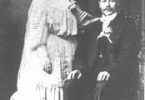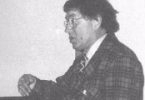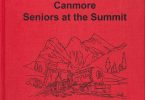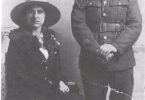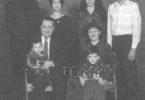Some Significant Memories
Red was an old sorrel that stumbled, uphill and downhill! Riding to town school was necessary to get a high school matriculation so I persisted, even after three years of spasmodic absenteeism: 1928, 1930, and 1932. Depression days were hard on parents of people like me who persisted, having to provide food: butter, milk, bread, potatoes, and even coal for a boarding place during desperately cold winter months and scraping up enough money for clothes, sometimes turning the old clothing items so that they would look new.
I was just beginning my life journey and full of youthful enthusiasm for the future which would be rosy (as we perceived it from reading our dime novels, the only reading material available). My brother, already at work with our uncle making paper, assured me of $15.00 per month if I wanted to go to Normal School in Moose Jaw for teacher training. It was a magic moment. Fifteen dollars would be half my board and I could do housework for the other $15. My tuition ($110) could be paid off later after I got a job but had to be paid off before I could get a teacher’s certificate.
Rural teaching was challenging – lots of kids, no books but Readers, and old editions of geography, history, etc. We had no aids except a “jelly pad” which was a jelly-like mixture that we poured on a flat pan, laid on a paper with a special ink and pulled off copies – not very fast! We always had to melt it down for the next set. With nine grades, seat work presented a big problem. Isolation from peers and boarding around to help pay some of the meagre wage of $40.00 per month, were more of the frustrations, offset, I might add, by the popularity of teachers at the social events that we enjoyed in the community.
Wood Mountain, Shaunavon, Limerick, Horizon and Melaval were some of the centres nearby where I could shop for personal needs. The good people of the districts helped as much as they could. This was the thirties and there was no such thing as welfare to draw on. In retrospect, the indomitable spirit of the prairie people continues to amaze me.
My marriage in 1941, near the beginning of World War II, was a turning point in my life. My husband, Neil, went overseas a month later and I lived with my parents, When our daughter, Lynne, was born, I remained with my parents and two of my brother’s children for nearly four years, – until “the boys came marching home again”. Then followed the aftermath of readjustment and a new “we” concept in my life.
Neil and I raised four children: Lynne, Rowan, Wilna and Peter while we lived in Lafleche, Saskatchewan. Those were the best and the worst years of our lives. Our fortunes rose and fell and eventually we left Saskatchewan and migrated to Edson, Alberta, in 1956, where I again taught school. We progressed to living in home with bathroom at this time. Our children thrived and graduated from school in Edson. Neil became weatherman and again we moved – this time to Canmore, via Peace River, Fort Vermilion and Banff. Neil died in Canmore in 1970 and I remained there until 1994.
The fabric of my life is a whole other story. The persistence and push that I have had is probably a result of my genes. My father’s family history has recently come into my possession, going back to the 1700’s which tells of a castle in Germany, near the border of France, where marauding raids caused a whole family to plan to emigrate to Brazil. Leaving from Calais on May 28, 1827, and their ship being storm-bound for six weeks, they finally landed in New York harbour, where they disembarked. They then travelled up the Hudson River to Albany, and then along the Erie Canal until they finally arrived at Chippewa in Upper Canada. Here, Andrew, Eva and six sons were given a large tract of land in Huron County as payment for clearing and building roads and inns. In 1929, a large stone cairn was erected on Seebach Hill in honour of their settlement work. My grandfather was one of the later sons who were born in Canada. Descendants of these spread to Western Canada and to all parts of the world. My mother’s family also came from Germany in the mid 1800′ s. She was a Kahle, one of nine children and, as I am prone to brag about, was a cousin of Howie Morenz, who was voted the greatest hockey player in the first half of the 20th Century.
My soul has been nourished by my faith in a “higher power” whom I chose to call God. I have been a searcher all my life and have a collection of books by the great theologians, Bonhoeffer, Kierkgaard, Frye, Kuhn and more recently Spong,Harpur and Fox.
Much of my life has been enriched through music, drama and handwork. My present passion is weaving, which takes up most of my days. I explore new ideas and my latest achievement is a Japanese kimono for which I designed and wove a special fabric.
During my retirement and with the collaboration of three other retirees, Jenny, Emily and Helen, I wrote the lyrics and melodies for a pageant to celebrate Canmore’s last 100 years – The Birthday Party – it was an exciting time to be working with children (about sixty of them) who provided the musical interludes and variety to the stage work.
I love to reminisce about, and view again, my many slides of travels which I took after retirement in 1979. My first long flight was to Thailand where Lynne, my daughter, and her husband Frank lived for five years. I recorded this trip on tapes – it blows my mind when I listen to the sounds of that exotic country. I spent seven months on a trip to New Zealand, Australia and Hawaii. I also travelled to Britain, Scotland and Germany. These were also memorable trips for me. I have enjoyed other trips to all parts of North America from the Arctic Circle to the Caribbean and from the Atlantic to the Pacific. Some of these trips were made with Elderhostel. I spent three years in California with my daughter, Wilna, which gave me a new perspective on life and appreciation for life in Canada. I really found out how precious a country Canada is.
Going way back to significant memories, a story must be told about life during the great depression. This happened during a year when I wasn’t attending high school, and other young people in the farming community were also marking time. We formed a group called the “Pepper Pals”, an antidote to the hard times. Our club admitted all singles, but no one over forty years of age. We camped, put on plays, arranged ball games and dances. Our motto was “Find a way or make one,” and that we did! Picture a bunch of girls (fifteen in all), in a grain wagon with our tents, bedclothes, and food, going six miles to the river – across the wind-blown, sun-baked, dried-out prairie with a cow to supply our milk dragging behind. Some of our brothers helped with the tents and then left. We had no chaperones – and ten days of bliss. Another poignant memory is that of waiting for the train to come into the Moose Jaw station – sitting up in the middle of the night with my daughter Lynne, waiting for a late, late train on which my husband Neil was returning from action in Europe. Neil had never yet seen our daughter until that time. It turned out to be quite an adjustment!
I have lived in an interesting and diverse time – from democrats and buggies to cars, airplanes, telephones, radios, T.V., refrigerators, packaged foods and, of late, computers and Internet. I would like to live to see “what else?” It has been a wonderful time for me and I am grateful for my family and wonderful friends, and the good times through my eighty-four years. The drama of life is always there for everyone, all the time, and no less during my days of teaching thirty-five years in all), during which I upgraded my education to a Bachelor of Education. I loved teaching. It brought so many satisfactions and delights to my life. (Christmas concerts come to mind!).
I am now retired for twenty-one years and presently living in Sherwood Park at Silver Birch Lodge, close to my daughter, Wilna, and a granddaughter, Jessica. I see Lynne and Frank from Peace River often. I also see their children Kari and Douglas. We all keep in close touch. I am enjoying each day with its interesting diversions awesome T.V. programs, the Choralaires (a group of forty-seven choir members that I sing with), my weaving, my reading (such marvellous Canadian authors) and dreaming of life through the eyes of the young generation.
One of my favourite slogans –
“Build a fence of trust around today,
Fill it full of loving work,
And therein stay.
Look not thru’ the gate upon tomorrow,
For God will help you bear
What comes —of Joy or Sorrow.”
Stats:
Hilda Gertrude Seebach, born September 28, 1916, near Melaval SK (10-09-04-3)
Married Neil Galbraith, 1941, Halbrite, SK (passed away 1970)
Children
Patricia Lynne, September 14, 1942
Rowan Alistair, January 18, 1947 (passed away 1968)
Wilna Elizabeth, December 6, 1948
Peter Edward, September 24, 1950 (passed away 1951)
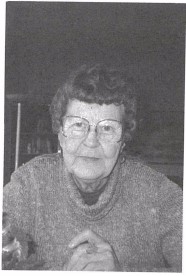
Gertrude Galbraith a few days after her eightieth birthday, 1995
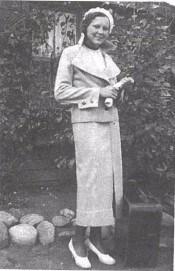
Gertrude Galbraith, off to teachers’ college 1934
In Canmore Seniors at the Summit, ed. Canmore Seniors Association, 2000, p. 93-95

